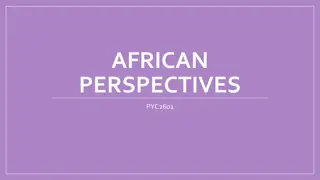Overview of Middle Eastern & North African Performing Arts
Middle Eastern and North African performing arts encompass a rich tapestry of music and dance traditions that hold cultural significance. In these regions, music plays a vital role in religious practices, with characteristics such as improvisation, ornamentation, and a focus on vocal music prevailing. Instruments like the oud and various drums are key to creating the unique sounds of Middle Eastern music. The hierarchy observed among musicians based on social class adds another layer to the cultural context of these art forms.
Download Presentation

Please find below an Image/Link to download the presentation.
The content on the website is provided AS IS for your information and personal use only. It may not be sold, licensed, or shared on other websites without obtaining consent from the author. Download presentation by click this link. If you encounter any issues during the download, it is possible that the publisher has removed the file from their server.
E N D
Presentation Transcript
Middle Eastern and North African Performing Arts An Overview
Major Performing Arts of the Middle East and North Africa Music Dance
Middle Eastern Music Major Characteristics According to Islam, music was once considered malahi Islamic philosophers like al-Kindi worried about its influence on behavior Religiously acceptable uses of music include: Calling Muslims to pray Chanting verses from the Qu ran Hymns for special occasions and holy days Dhikr
Middle Eastern Music (continued) Major Characteristics (continued) The music is generally highly improvised, with a single melody played by all instruments simultaneously Vocal and instrumental music is generally highly ornamented, featuring trills, glissandos, or short secondary notes Vocal music predominates
Middle Eastern Music (continued) Major Characteristics The primary instrument is the oud The most common musical form is the suite, a grouping of individual pieces The best music is thought to inspire a trancelike, higher experience of life Maqam (or a system of scales) are used as the basis of all melodic creation
Middle Eastern Music (continued) Major Characteristics There is a strict hierarchy observed between types of music and performers, with talented amateur musicians usually coming from a higher social class; professional or popular musicians are typically looked down on
Middle Eastern Music (continued) Major Instruments Tar 6-stringed long-necked, fetted lute Santour trapezoid-shaped hammered dulcimer Darbucca/Dombak/Zarb single-headed drum made from fired clay Setar 3- or 4-stringed small, long-necked, fretted lute Kamancheh 3- or 4-stringed spiked fiddle Oud 8-stringed lute with no frets Zornah wind instrument
Middle Eastern Music (continued) Genres Khandan the highest form of Middle Eastern music, used primarily in chanting the texts of the Qu ran Musiqi classical and folk forms of music that have less prestige than the religious Khandan
Middle Eastern Music (continued) Genres (continued) Maqam generic term for mode, or system of composing melody, in Arabic classical music (aka Dastgah and Gusheh in Persian and mugam in Azerbaijan Dastgah the mode or scale of a piece in Persian music
Middle Eastern Music (continued) Genres (continued) Radif in Persian classical music, the body of music, consisting of 25-300 short pieces, memorized by students, and then used as the basis or point of departure from improvised performance Gusheh subdivision of a dastgah, and smallest constituent part of the radif, in Persian classical music
Middle Eastern Music (continued) Genres (continued) Rai modern popular music developed in Algeria and Morocco that combines traditional singing styles and Arabic modes with Western-style synthesized accompaniments
Middle Eastern Theater Arab theater did not fully develop until the 19thcentury CE Arab Theater Genres Khayal al-zill shadow puppet theater that originated in the 10thcentury CE Oral Storytelling
Middle Eastern Theater (continued) Arab Theater Genres (continued) Ta ziyah - a passion play in Shi'a communities during the month of Muharram to commemorate the death of the Prophet Muhammad's grandson, Hussain, at the battle of Karbala in AD 680.
Middle Eastern Theater (continued) Persian Theater Genres Naqq li - one of the oldest forms of the traditional theater, the performer recounts stories in prose often accompanied by music, dance and decorative, painted scrolls. Ta'zieh - traditional religious theater in which the drama is conveyed through music, narration, prose and singing.
Middle Eastern Theater (continued) Persian Theater Genres (continued) Kheimeh-shab-bazi - traditional puppet theater. Siah-Bazi - Iranian folk comedic theater that features a blackface, mischievous and forthright harlequin that does improvisations to stir laughter.
Middle Eastern Dance Genres Raqs sharqi - it is more commonly performed by female dancers but is also sometimes danced by men. It is a solo improvisational dance, although students often perform choreographed dances in a group.
Middle Eastern Dance (continued) Genres (continued) Raqs baladi - many different folkloric dance styles, danced socially by men and women of all ages in some Middle Eastern countries, usually at festive occasions such as weddings. Ghawazi - traditional performative dance of the Egyptian Dom people iftetelli - Turkish folk dance found in the core territories of the former Ottoman Empire.
Middle Eastern Dance (continued) Genres (continued) Persian dance Chain or line dances Solo dance War or combat dances Ritual or spiritual dances Assyrian folk dance Khigga - a form of line dancing where individuals hold hands with the line following around the dance floor.
Middle Eastern Dance (continued) Genres (continued) Turkish Dance Bar Halay Horon Zeybek
Middle Eastern Dance (continued) Genres (continued) Al-Ayyala a popular dance in Oman and the United Arab Emirates performed during religious and national festivals and weddings. It involves chanted poetry, drum music and dance, and simulates a battle scene.























